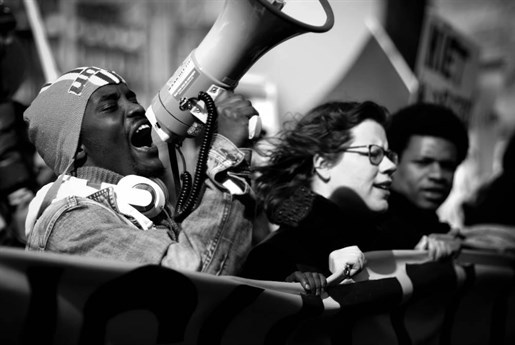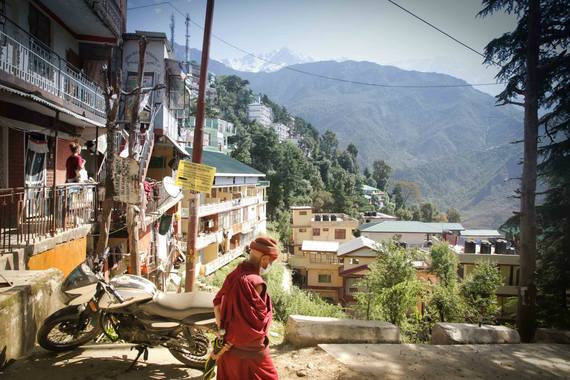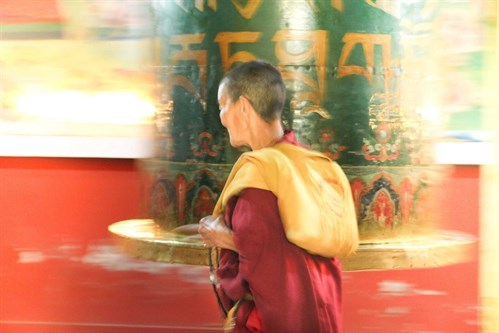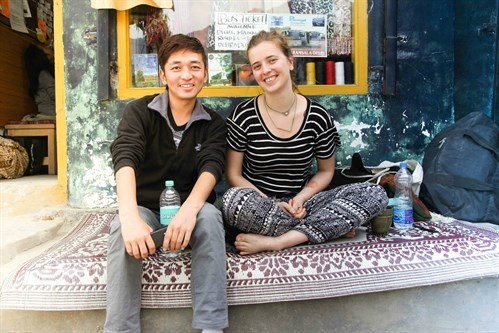Two years ago, on a cold winter day, I went to protest in a demonstration. I went to protest to protect the (human) rights of refugees in the Netherlands. It was a protest that perfectly fitted my idea of how a protest would look like. You probably have an image in your mind of a protest. Think about it. Really try to imagine it. For me, it looked something like this:
Well... it looked exactly like this. This was that protest two years ago.
I won't guess what you had in mind, your image might have looked completely different. But to me, the image of a protest has completely changed.
The way we protest depends on the historical, social and political context. In the democratic society of the Netherlands, we had the freedom to go onto the streets with the masses and 'occupy' the streets. We could shout, chant and say whatever we wanted. We walked for hours and hours, with a gathering and concert at the end of the walk. Afterwards, most of us disappeared. People went back home, dove into a pub, got a bite to eat and went with the refugees back to their own shelter. This was what a protest was to me. This was my association with a protest.
The way we define things is by association. We assign images, signs, and symbolic capital to a word and this is what that word comes to mean to us. The associations available are different for everyone. For me, a protest had become to define that image above. A protest became what I experienced myself. But the associations that accompany 'protest' will differ depending on the social, cultural, but mostly, on the political context.
The moment my conception of protest changed was when I spoke to Tashi.
Tashi is a 19-year-old Tibetan refugee living in Dharamsala, India. He fled Tibet when he was 9 years old. Fleeing Tibet isn't that easy though. Tashi embarked upon a journey I can't imagine. Joining a group of 21 - many of whom kids (some even younger than him), mothers and monks - they set off on a journey they will never forget. Tibet is located so high in the sky that they refer to it as 'Roof of the World'. Its location and mountains make it one of the most elusive locations of the world. The icy mountains form a fairytale-like wall around the territory. The only way out of Tibet, is to bite through the ice.
Until 1949, Tibet was an autonomous Buddhist nation in the Himalayas. Religion was what unified the Tibetans, as did their language, literature, art and world view that they developed living on the roof of the world, under harsh natural conditions and in separation of the rest of the world. In 1950, China invaded Tibet. The 17 point agreement a year later stated that China would not "alter the existing political system in Tibet" and that "in matters relating to various reforms in Tibet there would be no compulsion on the part of the central authorities". As the years went on, the resistance grew. The capital Lhasa became filled with refugees from Eastern Tibet. In 1959, fearful of plans to abduct the Dalai Lama, 300.000 Tibetans took to the streets and surrounded the Palace to offer protection. A week later, the Dalai Lama flew over the mountains to India. From 1960-1962, Mao implemented his catastrophic campaign "The Great Leap Forward" aiming to rapidly transform an agrarian economy into a communist society, which led to the death of hundreds of thousands of Tibetan peasants and nomads. Thousands of monasteries were also destroyed. A few years later, Mao's movement to enforce communism continued onto every aspect of society and led to the destruction of many Buddhist monasteries and cultural sites. This went on for years. China continued to enforce its cultural and political power which led to the suppression of the freedom of Tibet. In 1989, 30 years after the National Uprising, Tibetans took to the streets, only to be met with brutal force. Chinese authorities expelled all foreigners and declared martial law. In the years that followed, China strengthened its control. In 1996, China launched a patriotic re-education campaign for Tibetans.
The continuingly growing force and control of the Chinese leads to a growing number of Tibetans who don't feel they can be Tibetan in Tibet. The religion, culture, arts and language that once unified the Tibetans, was now suppressed. Many decide to flee. Over 150,000 Tibetans now live in exile, most of them in India or neighboring Nepal.
So does Tashi. At 9 years old, he decided it was enough. From a very young age, he loved school. He always dreamt about going to university. But in Tibet, everything is directed towards the Chinese. The only language in schools or universities is Chinese, and all the education is colored by the regime. His mother knew he could do better. He could do great, but the Chinese kept him down. His mother made the incredibly difficult decision to send him away. Tashi would undergo an immense journey to flee Tibet, leaving his mom and two brothers behind.
Fifteen days of trekking through the mountains. Something adventurous tourist do all the time to find peace of mind and freedom, something Tibetans do for the exact same reason. The tourist climbers do it for the journey, the Tibetans do it for the destination. "It's about the journey, not the destination" doesn't really apply anymore. There was nothing good about this journey.
"Why am I doing this to myself?" Tashi asked himself continuously while he was on this journey through hell. They walked nights, never during the day. The Chinese had patrol all over the mountains during the day. Instead, they hid and slept at daytime, and trekked night-time. All Tashi had with him was a small rug sack with some water and bread. The gear consisted of the human body, faith and resilience.
Tashi told me he was scared as hell. He was in hell for those 15 days. The journey was extremely dangerous and difficult and he counts himself very lucky to come out of it safe. In his group, no-one died, but one monk did lose his toes due to frostbite.
They arrived in Nepal, at a 'Tibetan Refugee Center'. For another two weeks, they stayed here until their journey to India continued. At least now they had food, shelter and they were away from Chinese control. They had nothing, but they were safe. After two weeks they moved on to Dharamshala, India. The same place the Dalai Lama escaped to. Finally they received a warm welcome. They got offered free shelter and were accompanied by many other Tibetans.
Ten years later. Tashi still lives in Dharamsala. But he has applied for University. He wants to study Political Science in Delhi. In his body and mind, he wants to help Tibet and Tibetans. Through Political Science he wants to learn about systems, structures and politics in order to be able to change it.
"Its up to the people in exile, to change the situation in Tibet", he says, "the people who are still living there can't do anything, so we have to. We have to show the people in Tibet that things can be different."
Tashi calls his mom as much as he can. "She couldn't leave Tibet. Her whole life has always been there, it would not feel right. But my mom always says she is so proud of me," Tashi says. He got to meet the Dalai Lama, talk with him and live in his city - a dream that has come true for him, and his mom could not be more proud. "But our conversations are very limited", he explains. "The Chinese government tap into our phone lines and whenever we discuss anything political, the lines gets cut off. So we keep our conversations very basic. We withhold talking about anything political." "Once", he tells me, "the phone lines got cut off for a really long time. For months, I couldn't call my mom. When I finally spoke to her again after those months, she burst out crying. Although, to be honest, she cries almost every time we speak", he admits.
"My mom doesn't know I want to study Political Science. She keeps asking me what I will study. The only thing I can say is English and Tibetan. So that's what I say." If it is up to the Tibetans in exile to bring about change within Tibet, the restrictions on conversation make this even harder to achieve, is what I keep thinking.
In Tibet, you're no longer allowed to have pictures of the Dalai Lama in your house. Or anywhere, for that matter. "My mom secretly does have pictures of his holiness in her house. Everyone does. But they're just generally covered by other pictures. Only on important religious days she reveals them", he explains.
I ask him about his brother, the monk. As a monk, I would think, you are automatically a more politically charged being, open for scrutiny from the Chinese government. Your title carries with it something the Chinese would dispute. "My brother works in a monastery, one of the ones that still exists. The monastery is not really allowed any pictures either, but of course they have them, they just hide them. The Chinese patrol is around the corner all the time. They just stand outside the monastery, observing and controlling."
The strict totalitarian regime of China and the nature of the Buddhist religion make the kinds of protest that the Tibetans have at hand very different. The Dalai Lama doesn't support aggression and the religion he promotes is one of peace and freedom of violence. When Tibetans tried their hand at 'conventional' protest, they were met with brutal force from the Chinese. Since the late 90's, some monks took another route. Monks set themselves on fire in public; self-immolation. Since 2009, over 140 Tibetans have self-immolated in Tibet, 99% of them after 2011. 24 of them aged 18 years or younger. It's a form of protest very different from other protests. It is too politically charged to be a stand-alone suicide (even though there is something to say for every suicide being a political reflection of the society). But it is too individual to be compared to a suicide bomber; it is not meant to harm anyone but the protester. In a way, it protests what we see as protest.
That day two years ago, the day I protested to protect the rights of refugees, I took the train to Amsterdam in the afternoon. I spent 5 hours walking around in the freezing cold, to get back in my train and return back home. I spent the rest of my evening talking in a pub. The next day, some journalists had brought out articles or news on the protest. That was it for my protest. In a democratic society, and if the protest is big enough, this can bring the change in regulations. This can indeed raise the awareness of people all over the country and bring about the change that was desired. But in a totalitarian regime there are no journalists that report this, there are no possibilities to organize such a protest in a similar way. People have to find other ways to protest the current political system. They resort to other forms of protest. Much harsher and more impactful forms, like self-immolation.
In a different political context, the forms of protest change. This is not necessarily something new, I know. What I do wonder, is why these forms of protest are relatively little discussed in the media in other countries? If I take the West as an example - which knows most democratic societies and possibly most protests like I described - the self-immolations in Tibet are relatively undocumented. Remember Jan Palach? In 1968 he committed self-immolation as a political protest to end the Prague Spring. His name is remembered forever in many minds and history books all over the world. Talking about impact. Those 140 self-immolations in Tibet are without name. People will have heard about it, but the sheer amount of these deaths is relatively undocumented and the names remain too anonymous.
Why? Maybe it is because China is just really good at keeping away international press from these actions, maybe it is because the West has too much to gain from a connection with China, or maybe it is because many of us uncomfortable with these types of protest. Maybe, we are so closed to this form of harsh protest, we refuse to cope with it. To really understand it. To try and imagine it. It is too quiet. It is too 'small', too personal, too painful. It is difficult to digest. Whereas women in Iran taking of their headscarf as a sign of protest, is also small and personal, but peaceful and not physically painful. It is easier to digest. I can't put my finger on the reason, but probably, it is a combination of all of the above.
When I asked Tashi about the self-immolations, his tone changed.
When I first heard of it, I was shocked. Very shocked. In the years following, I heard that some monks from my village did it, too. I used to live in a really small village. Like, really small. Everyone knew each other. Three guys I went to school with and who lived in my village, set themselves on fire in aid of freeing Tibet. I knew them quite well. I was just shocked. All I could really do was go to the temple and pray for them. Just pray.
That is probably the only thing you can do when you hear of these self-immolations. It's what happens to me too. I was shocked. Sad. Terrified. Which is probably what these acts do for most people, but in a lot of ways, this form of protest is the biggest I have seen so far. It is not personal at all, it is not individual at all, and mostly, it is not small. It is contextual.
As I said earlier, we define by association. It is not the word that matters, it is the meaning we give to it through images and symbols. It is the mysterious mental processes which give us an image of what that word means. Language is a mental process without which language would be empty. If associations differ, just like the mental processes and the meaning, we start to misunderstand each other and we fail to unite. Political and social contexts differ, and therefore the mental process which associates meanings to words differ. My idea of a protest was limited and framed through one glass.
"Do you think things are going to change?" I asked Tashi. "Yes, I believe so. We have a long way to go but I believe we can. Things will have to change from outside though." If things are going to have to change from outside, the outside needs to pay more attention to it. We need to understand the cries for attention from inside, and we need to act towards the change. But we might need to change our language of protest to be able to deal with it. We might need to look at the silent and symbolic protest, the human body as protest.
Yes, I have been to a protest. A type of protest Tashi has never been to, probably. But Tashi walked over mountains, crossed through ice and dealt with fire to find freedom and help Free Tibet. His protest was silent, symbolical, personal. His whole life has been a protest. Talking to Tashi, I realized he transformed my language of protest. He opened my eyes to other understandings of protests. Now, he symbolizes protest for me.
I told Tashi about World Merit. About our community of changemakers who support each other in their mission to change the world. I told him I would tell his story to you. For you to support him, for you to encourage him, but most of all, for you to listen. And maybe, for us all, to unite by expanding and changing our language of protest. For us all, to participate in his protest.





